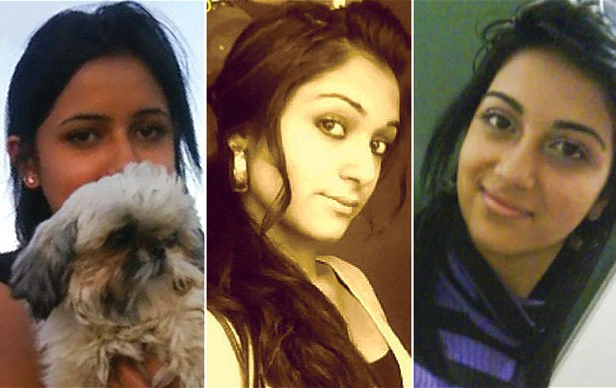Posted by Tara Atluri
A direct flight runs from Delhi to Toronto, from Toronto to Delhi. The South Asian diaspora in the city of Toronto and surrounding areas as well as the rest of Turtle Island, often referred to by its colonial name ‘Canada’ is ever expanding. Multicultural branding of brown Others as ‘exotic’ and the relentless use of the word “culture” is used to explain everything from caste-based racism to misogyny.
On February 14th in the greater Toronto area Raya Rajkumar, an eleven-year-old girl was murdered by her father. On Valentine’s Day, a day often used to celebrate an ethos of love, a man murdered his daughter in a ghastly example of male violence, even
Tourists wander eagerly through streets of cities that brand themselves as ‘multicultural’, looking for food to eat, to ‘experience another culture’, looking for things to watch and things to buy. And yet, to discuss the lived traumas that women of colour and immigrant women experience is not the kind of saleable narrative or store-bought jingle that will ever be heard. Canadians are just too ‘nice’ for that.
Indian feminism can and should extend across borders. We should remain haunted in the best ways
Niceness much like whiteness is both everything and nothing. As empty as promises often made to Indigenous peoples whose land is settled by wave after wave of immigrants. We tell stories that produce good feeling – ones that make us feel benevolent, redeemed, and kind. While many in the South Asian diaspora and the wider mainstream public in the Global North are horrified by cases of gender-based violence in India and other Global South countries, the ways that white settler violence structures the deaths of women of colour is wilfully forgotten with stories of immigrant success.
Sara Ahmed writes of the ‘feminist killjoy’ who disrupts narratives of blissful ignorance that turn lives of oppression into happy, quaint platitudes of forgetfulness.
From 2012 onward there has been consistent research demonstrating that South Asians who immigrate to Canada have been aborting female foetuses. While female infanticide is legislated against in India, in Turtle Island, what exists is an eerie silence that is criminally ‘nice’. Over
As a woman of colour in Turtle Island, whose parents immigrated from India, traces of India in products and names are met with
The murders of brown women in Canada become ‘community issues’ that are dirty and sordid, unlike the store-bought ‘diversity’ used to sell ‘Otherness’ as kitsch and worldliness. Unlike yoga mats and Bollywood film, forced abortion of female foetuses is surprisingly not a high selling point for cities and countries looking to turn sexism and casteism into ‘culture’ and culture into profit.
The violence of caste-based endogamy turns
Like multicultural tourist festivals, brown people become eye candy, held at a safe and sanitised distance from the five-star resorts of whiteness.
The South Asian diaspora and its tourists mystify gendered, caste and class relations in convenient ways. Political leaders also omit not nice words such as misogyny, racism, and murder. There has been little consistent political outcry regarding the practice of female infanticide among South Asians in Turtle Island.
While Justin Trudeau brands himself as a #feminist and South Asian Canadian NDP leader Jagmeet Singh tells tales of having ‘survived racism’, thousands of South Asian Canadian female children are simply not born. Like thousands of Indigenous women who have been systematically destroyed, disappeared, and murdered, journalists refer to these women as ‘missing’. What is missing from the glorification of Canada, as a feminist and multicultural utopia are the cruellest truths of money and misogyny.
Justin Trudeau is the kind of white man in a Kurta that many in India and the diaspora love to see. Jagmeet Singh is a South Asian man and therefore the kind of person that we can see and want to see, beyond statistics of female infanticide. These are lives that have value. These are names that we will remember. These are lives lived.
There are those who will never be cast as characters in our diasporic tales of blissfully rich ignorance. Young girls whose lives are as disposable as ethnic kitsch, token brown women, dead daughters, she who was never born.
The appropriate legal and political response to female infanticide propagated by South Asians in Canada is debatable. However in order to debate, one must first enter into dialogue.
Many times, in a ‘nice’ place, educated white liberals do not want to appear racist and remain silent regarding the sexism of immigrants and their cultures’. This gesture of imagined benevolence is the ultimate act of racism as it constructs ‘Others’ as being out of the bounds of human empathy. South Asian ‘communities’ in the diaspora also often romanticise ‘culture’ and ‘family’ in ways that normalise violence against women of colour. The glaring absence of national outcry coupled with the glorification of multicultural exotica, is chilling.
Also read: What Is Killing Kashmiri Women And Why Aren’t We Talking About It?
Indian feminism can and should extend across borders. We should remain haunted in the best ways. In ways that inspire us to see life and to see feminism, as precious. As precious as human dignity.
Tara Atluri has a PhD in Sociology. She completed postdoctoral studies as part of the research project, Oecumene: Citizenship After Orientalism.
Featured Image Source: Vice




